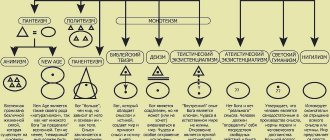What are needs
The key word in defining the concept of need is “need”.
Need
- this is the need for certain things, objects of the material world, objects, people, social indicators, in the absence of which a person feels uncomfortable.
Taking into account this definition, neediness, in order to become a need, must meet the following criteria:
- A lack of need causes a feeling of dissatisfaction. A need is something desired, a good.
- Accompanying with emotions: from negative at the first stage to joyful after the need is fulfilled. When we really want something, we get nervous and anxious; when we get what we want, we relax.
- Fixation on the subject of need. Consciousness snatches from reality those things that can satisfy us. For example, if we are hungry, we will focus on the food and the smell of food.
The system of needs is also formed according to special rules:
- Need is common to all living beings on the planet. But the more developed the species, the higher the level of needs. The tree has enough nutrients from the soil, sunlight, and rain watering. Man, as a highly developed animal, needs much more.
- The older the person, the more extensive the list of what is required. A baby can do without things that an adult needs.
- Needs are a strictly hierarchical structure, some are primary, others are secondary.
People's actions are dictated by the presence of a certain need, which is the main motivator of activity. Motivation to get what you want moves a person forward and forces him to act. Everything that has been created by people throughout the history of mankind in politics, economics, art, science is the result of activities to satisfy needs.
The inability to fulfill needs can lead to dependence on their importance for the individual and to the following various consequences:
- Physical death of a person
. If the need for food, sleep, water, air, safety, etc. is not satisfied. - Frustration
is a long-term experience associated with a nervous disorder and can lead to serious psychological problems. An example is the lack of recognition of a person’s merits by society. - Sublimation
- the transition of the energy of dissatisfaction into creation, creativity. For example, the absence of sex is replaced by heavy sports activities.
Thus, needs should be listened to and efforts should be made to realize them.
Characteristics of needs
Needs have a number of characteristics and are subject to certain laws:
- At birth, a person is characterized only by physiological needs, the rest develop later.
- The lower needs are characteristic of all people equally.
- The higher ones differ greatly from person to person and form an individual portrait of the individual.
- Satisfaction of lower needs opens the possibility for the formation of higher ones, but does not guarantee it.
- The higher the need, the less important it is for survival and the longer it may remain unsatisfied.
- The more a person is involved in various activities, the more complex his system of needs.
- Suppression has a negative impact on psychological and physiological well-being and deforms the personality.
- The occurrence and satisfaction are associated with various emotions.
- A person's focus is fixed on the subject of need and causes attention to flow in its direction.
More than 100 cool lessons, tests and exercises for brain development
Start developing
What needs does a person have?
Man is one of the representatives of the animal world, with instincts and needs inherent in other species. At the same time, we have higher intelligence, feelings, and strong-willed qualities. This combination causes the presence of needs at two levels: basic and additional (primary and secondary).
Basic Needs
This group is vital for humans as a biological species. Basic needs are divided into two groups.
| Physiological | Existential |
| Breathing, nutrition, thirst, sleep, rest, procreation, housing. | Comfort, social and legal security, availability of employment, etc. |
Physiological basic needs must be satisfied first, since without them existence itself is impossible. The listed things and phenomena have been inherent in man since primitive times.
A person tries to make the process of satisfying basic needs more comfortable. If at the initial stage of the development of the human race animal skins served as clothing, today a whole industry is working to clothe us.
Basic needs can change with age in favor of the predominance of some over others. Sleep, for example, is more important for young children and older people, but in our youth we are able to get by with minimal hours of rest and still feel alert. Sex, as a primary need, can also, for a number of reasons, lose priority with age, but in adolescence it is a priority.
Questions often arise about security as a necessity for existence. Man has always experienced danger from phenomena in the surrounding world or from other people. A tsunami, a collapse of glaciers, an attack by wild animals or other tribes - all this forced a person to defend himself or run away. Over time, entire institutions were formed that were supposed to protect the individual from external incursions (army, police, Ministry of Emergency Situations). That is why safety is a primary need; we must understand that our lives and property are protected and protected.
The needs of existence (existence) appear as an individual grows up and determines his place in society.
Secondary needs
If a group of primary needs is necessary for survival and is laid down at the genetic level, then secondary needs determine a certain level of a person’s quality of life and come and are transformed with life experience.
Among the secondary needs in theory, the following are identified:
- Spiritual
. These include the need to obtain new knowledge about the world, the search for the meaning of life and one’s place in it, the development of creative abilities, and the desire for harmony. - Social
– love, friendship, interaction with other people, feeling part of society, a separate social group (class, work team, family). - Prestigious
. We are talking about the need for recognition of our successes, worthy self-esteem, respect from other members of the communities in which we belong.
Thus, primary needs are innate and determined by physiology, while secondary needs are psychological in nature and develop throughout life.
↑ Interests and inclinations
Interests arise based on needs.
Interest
- a person’s purposeful attitude towards any object, the desire to become familiar with new facts about it, to study it more completely and deeply.
People's interests are directed not so much at the objects of need, but at those social conditions that make these objects more or less accessible, first of all, material and spiritual goods that ensure the satisfaction of needs.
Interests are determined by the position of various social groups and individuals in society. They are more or less recognized by people and are the most important incentives for various types of activities.
Sometimes interests develop into hobbies of life or become its meaning. In the process of satisfying some interests, a person often acquires new ones, which gives him the opportunity to constantly improve.
There are several classifications of interests :
- by focus:
social, economic, political, spiritual; - by degree of community:
individual, group, public; - by content:
direct (interest in the process of activity itself), indirect (interest in the results of activity); - by the nature of the subject
: national, state; - by level of activity:
passive (limited to the perception of the object of interest), active (a person acts in order to obtain the object). - if possible, their implementation
: real, imaginary;
When considering the concept of “interest”, we must compare it with the concept of “inclination”, since they are the result of a person’s need for a certain activity. Interest is a person’s focus on an object, and inclination is an activity. For example, when they say that a young man is interested in football, they mean that he likes to watch football matches, collects information about famous football players or teams, and when they say that a young man has an inclination towards football, this means that he plays football well.
Addiction
- focus on a specific activity.
A person’s interests and inclinations express the direction of his personality, which determines his life path, the nature of his activities, etc.
Interest is not always combined with inclination (much depends on the degree of accessibility of a particular activity). For example, a person's interest in cinema does not necessarily entail the opportunity to work as a film director, actor or cinematographer. But interest in chess arises along with the inclination to play it.
A person’s interests express the direction of his personality, which largely determines his life path, the nature of his activities, etc.
Unified State Exam in Social Studies / Man and Society Unified State Exam
All needs of man and society as a whole are divided into two categories: natural and unnatural; in addition, there are certain limits of minimum and maximum in the satisfaction of natural needs, beyond which the same needs become unnatural. As a result, everything produced in the social association of labor and consumed from nature in finished form belongs to two spectrums of products:
- demographically determined needs (DNP)
, the satisfaction of which ensures the existence of individuals and their families and personal development, and the volume of which in all natural and geographical conditions is limited, since it is subject to the natural physiology of the human body, the number of families, the population in the region and the historically established way of life . Demographically determined needs cannot be anti-biosphere, since they must ensure the life of humanity in the continuity of generations, and humanity is part of the Earth’s biosphere;
- degradation-parasitic needs (DPN)
, the satisfaction of which undermines the life potential of both the individual consumers and their descendants. In contrast to demographically determined needs, degradation-parasitic needs are unpredictable and in principle impossible to satisfy them, since their reproduction in society is characterized by the proverb “the fat gets mad” (the latter can only be cured by fasting in all senses, directly productive labor in the sphere of material production and prayer, used In total). All needs, the satisfaction of which destroys biocenoses and the biosphere of the Earth and excludes the resumption of biocenoses in natural rhythms for the biosphere, are degradation-parasitic needs.
Types of needs
Needs can be classified on various grounds, of which there are quite a lot in the theory of psychology. The main types of division of needs are presented in the next section.
If we summarize all available theories, then we should distinguish three basic types of human needs.
Biological or physiological
Among the innate human needs laid down at the genetic level are the following:
- Food safety and taste characteristics.
- Comfortable external temperature and electromagnetic background.
- Clean water suitable for quenching thirst.
- Healthy ecology.
- Safety of life and home.
- Sexual satisfaction.
- Disposal of waste products.
These things are necessary for any living creature. This set of needs has practically not changed since the creation of the world, since from a physiological point of view, we are the same as millions of years ago. A person strives to realize them first and foremost and immediately.
Spiritual
Existential needs come from a system of universal human spiritual values, including: beauty, mercy, tranquility, harmony, peace, art. Each person has their own spiritual needs (as opposed to biological ones) and change over time and experience.
Among the spiritual needs are the following:
- The need for knowledge
. A mature person understands that in order to further grow, he must constantly learn. Moreover, expand the boundaries of existing skills and acquire new ones. People enter educational institutions to receive additional education, take advanced training courses, master new professions, and master the basics of painting and music. - The need for constant work on oneself, improving one’s personality (self-improvement)
. By satisfying this need, we quit smoking, go on a diet, get rid of toxic people and harmful emotions. A person thinks about how he would like to see himself after a certain period of time and strives for this. - The need for love and personal happiness
. The vast majority of people dream of having a loved one of the opposite sex nearby and creating a stable family. Many have been searching for many years, this need is so strong.
The realization of spiritual needs can be carried out through the simplest things. For example, a person goes into nature and sits with a fishing rod, fishing. At this time, he reflects, calms down, acquires spiritual harmony, satisfying his need for peace and making plans for the future.
Social
This type of needs is aimed at understanding one’s place in society and is associated with groups of people, social and economic activity.
Examples of social needs:
- Personal identification
. A person positions himself as a part of society with common traits inherent in society or a separate group. At the same time, he recognizes himself as an individual unit with a set of specific qualities and characteristics. - Self-affirmation
. We want to be satisfied with ourselves, with the actions and deeds that we perform. It is also important for a person to feel significant in society, to enjoy respect and approval from other people.
- Altruistic aspirations
. The individual takes pride in actions aimed at helping and assisting other people or living beings. He needs to be needed, useful, even in conditions of abandoning his own interests.
All of these types of needs are interpenetrating, they complement each other, some follow from others. For example, having satisfied the spiritual need to acquire a profession, we strive to achieve success in work for which we will be praised, and this is already a social need.
Page 14 of 24
Human activity factors
The social life of each individual, social community, or group of people is characterized by many factors. These factors determine the conditions and circumstances of a person’s real existence.
First of all, they distinguish biogenic factors, or the biological foundations of life, associated with the hereditary constitution and functioning of the bodily organism. Humans need food and water. In addition, conditions are required to survive in everyday reality. This could be shelter from bad weather and adaptation to changes in climate and seasons, clothing, shoes, etc. A capable person must have the necessary qualities and abilities, the level of development of consciousness and body, ensuring the appropriation or production of goods necessary for his own life and procreation, raising children.
All components and properties of a person are actively developing and, therefore, changing. In this regard, a person has new needs, and he constantly strives to provide favorable conditions for his existence, adapting to the society around him and producing various goods - things, information, services. Active satisfaction of needs is a natural basis for human activity and the driving force for the development of a person as an individual.
The primary source of activity is the needs that reflect the objective conditions of human existence and are one of the forms of his connection with the outside world. Need is a conscious understanding of the need for something and a meaningful orientation towards activities to satisfy it in real conditions. In realizing needs, a person, as a self-regulating system, needs to exchange information, energy, and substance with the environment. All this ensures sustainable stability and progressive personal development.
Basic human needs are combined according to the characteristics of their natural basis and are divided into physical, biogenic, bioethical, social, neurophysical, psychophysical, spiritual.
Physical, biogenic needs involve maintaining the integrity of the body and body systems, maintaining the necessary homeostasis of the body’s environment and basic vital functions (physical condition, satisfaction of hunger and thirst).
Bioethical needs determine the adaptation and implementation of genetically inherent mechanisms of reproduction, survival and progressive development through the use and development of natural resources of the environment and the body. They provide security of existence, health and biovital comfort.
Social (communication) needs are associated with the establishment and implementation of interaction and relationships with other people, procreation and the transfer of accumulated vital social functions and norms. These needs are manifested in the performance of production and labor activities and in communication with members of the community; contribute to the achievement of a strong social status and ensure sustainable stability of living conditions.
Neurophysical and psychophysical needs reflect the impulsive reflexive-emotional reactions of an individual to specific situations of life. These can be emotional and existential needs for self-manifestation, actualization and self-affirmation in the social environment, in the natural environment, in the world as a whole. They manifest themselves in psycho-emotional comfort, as well as in public recognition of the merits of the individual and human affairs.
Spiritual (information) needs are aimed at the creative transformation of incoming and accumulated information, self-realization of spiritual energy in ideas, things and actions. These needs are key in the search for truth and meaning in life, in gaining and feeling freedom.
The above needs can be innate, natural (biogenic), lifelong (sociogenic), ideal (psychogenic).
Needs are characteristic of every individual. As a highly organized and open system, a person needs self-production and at the same time constantly carries out active activities to satisfy emerging, growing and changing needs for various reasons. By this, he provides himself with a full life, necessary and sufficient conditions of existence, as well as comfort and relative reliability of life, a healthy image and lifestyle.
Human activity is always associated with the solution of existing problems or the desire to achieve certain conscious goals. A person also strives to learn ways of behaving in society. All this becomes achievable when there is motivation and vital activity. The direction and effectiveness of an individual’s activity will largely depend on the qualitative characteristics of the group of which he is a member, and on real intergroup interaction.
Social activity is a social quality of a person, manifested in the ability of an individual and groups of people to purposefully interact with the environment. It is characterized by an internal readiness for action and manifests itself as a conscious and energetic activity aimed at transforming reality and the people themselves. One of the indicators of a person’s social activity is his collectivism.
The process of forming a socially active personality is a complex pedagogical problem. Objective difficulties lie in the need to take into account the differentiation of the social structure of society, the specificity of people’s living conditions, social experience, level of education, and culture. Subjective difficulties are associated with the very nature of the tasks, namely with the need to regulate the diverse forms of the social environment in which the individual develops and acts.
Some forms of this environment, namely various environmental groups, develop predominantly spontaneously and are least amenable to targeted social influence and control. But at the same time, they have a strong influence on the attitudes and motives of an individual’s behavior, on the system of his value orientations.
Interest is the conscious focus of an individual or group on a value - an object of development. It acts as a stimulator of active search and productive activity to satisfy needs and reproduce the physical and spiritual powers of a person. Interest manifests itself in two psychological states, such as attention and desire. A special form of activity - social interest - is associated with the development of the values of a social group.
The realization of interest is preceded by a person’s attitude towards the object of attention. Attitude is the readiness of an individual for a certain active activity, which depends on the needs and specific conditions (D.I. Uznadze). An attitude can be considered as a subject’s readiness, his predisposition to purposeful, sustainable activity in relation to a specific object of influence (A.V. Pokrovsky). In addition, the attitude is understood as the internal readiness of the individual for a specific activity (M.E. Duranov, V.B. Orlov).
Optimal satisfaction of human needs is the primary reason for achieving success in physical education and sports activities.
Physical education, sports and tourism influence the biogenic processes in the human body and provide it with certain benefits, such as:
– obtaining and consolidating applied skills and abilities;
– achieving and maintaining optimal readiness for professional work through the development and use of new types of spiritual and physical activity;
– improvement of psychophysical abilities and qualities;
– achieving and maintaining physical perfection, ensuring a rational motor regime;
– prevention of deviations from the norm of physical condition;
– compensation for one-sided influences of the environment and activity;
– rehabilitation, restoration of physical strength, energy and plastic resources in the natural cycle of human life;
– rehabilitation of abilities and qualities weakened as a result of abnormal negative deviations from the normal state of the body, and elimination of pathological changes in the body, etc.
The manifestation of human activity in society with other people and social institutions is not chaotic, but is characterized by certain norms and rules - behavior. Behavior is determined by the social consciousness of the individual and the civic position of the individual and largely depends on culture.
Culture (from the Latin “cultivation, processing”) is a non-natural phenomenon and the process of people making progressive changes in the material and information environment, in social practice.
An undoubted cultural benefit for humans is the variety of information and functional processes that accompany physical education, health, tourism and sports hobbies. They smooth out negative emotional stress, organize a culture of behavior and lifestyle of people. At the same time, a lack of education can lead to negative consequences for any cultural event.
In introducing a person to the values of physical culture, the media are of great importance: radio, television, newspapers, magazines, etc. But it should be noted that they can have both positive and negative effects. This was clearly demonstrated in the broadcast of a football match between the national teams of Russia and Japan at the World Cup in 2002. A crowd of angry fans, dissatisfied with the results of the match, began to destroy everything that came to hand. This primarily testifies to the education of young people in the country. In general, the media have a positive effect on introducing people to the values of physical culture and sports.
Sociological analysis of human cultural behavior is largely based on natural scientific information, in particular psychoanalytic data.
A person basically consciously makes decisions about his behavior and changes in living conditions. In systematic psychoanalysis, the Austrian doctor S. Freud concluded that the development and state of the human psyche is actively influenced by the phenomena and mechanisms of unconscious natural needs. In his opinion, the general energetic principle of human behavior is instinctive drives: “ mortido ” - aggressive and “ libido ” - sexual. They are based on innate needs and instincts and do not depend on the will and reason of people.
At the same time, in society, the influence of surrounding people forms certain social norms in a person, which is the basis of behavior. These norms, like culture, being a set of restrictions and prohibitions, lead to the displacement of primary (natural, natural) needs and drives from the organized life of a person. A person is forced to live and act in society, in accordance with established norms and rules, traditions and laws. However, instincts repressed into the sphere of unconscious desire do not disappear without a trace.
The desire to satisfy sexual needs is, according to Freud, the main factor in all human behavior. Its proper satisfaction equals mental health. Dissatisfaction as a result of forced sexual abstinence causes a person to suffer from anxiety and biogenic discomfort, which affects his emotional stress and social behavior, leading to aggressive actions.
Physical exercise, healing the body, contributes to the sustainable preservation and maintenance of a person’s sexual functions, which in turn helps to satisfy his most important life needs.
These needs are realized in specific social behavior, in physical education and sports activities. The abstract concepts of “sport”, “physical education”, “recreation” are filled with real life only thanks to and as a result of the activity of people satisfying their particular needs.
Among the various motives, a person is characterized by the most powerful and prestigious ones. This could be a desire to become great, to make a career, a thirst for power, leadership, etc. Prestigious motives are based on an objective vital need to maintain the constancy of the internal environment and the stability of the state of the external environment favorable for life.
Sports and especially high sporting achievements create conditions for satisfying a person’s needs for prestige. Prestige (from the French preesstige - charm, charm) - public opinion about the recognition of merit.
The desire to satisfy needs leads to the emergence of a motive for action in a person. The term “ motive ” (from the Latin movere – to set in motion, to push) is polysemantic and is used to define all those factors that cause any action.
The conscious motive of a person’s actions acquires content with the help of words and has a specific formulation. If a person has not formulated the motive for an action, then such an action turns out to be unmotivated. A motive, fixed in the mind in verbal form, allows one to outline the goal of an action, which turns the action into activity .
Often the reason for the initiation of actions is emotional factors associated with a person’s previous experience and his current mood.
<< Previous — Next >>
| Table of contents |
| Sociological structure of physical culture and sports |
| Didactic plan |
| Preface |
| Sociology of physical culture and sports as an educational and scientific discipline |
| Physical culture and sport in society |
| Structure and levels of sociological knowledge about physical culture |
| Tasks and functions of the sociology of physical culture |
| The main problems of the sociology of physical culture and sports at the present stage of social development |
| Physical culture and sports in the system of public relations |
| System of public relations |
| Social institutions as forms of physical culture and sports organizations |
| Personality in the sociological structure of society |
| Man as a phenomenon of existence |
| Human activity factors |
| Sociological concept of personality |
| Socialization of personality |
| Family as one of the instances of socialization |
| School as a fundamental institution of socialization |
| Essential factors of socialization |
| Social affiliation |
| Sociological structure of society |
| Trends in changes in the social structure of society and their impact on physical culture and sports |
| Social functions of physical culture and sports |
| Sport as a social phenomenon |
| All pages |
Classifications of needs
Theoretical psychology offers many classifications of needs. We have already discussed one of them above: physiological, social and spiritual, these are the main groups of needs.
Foreign researchers did not so much classify needs as offer a specific list of them.
Examples:
- G. Murray
- achievements, aggression, independence, sex, creativity, understanding, respect, self-knowledge. - A. Pieron
- novelty, hedonism, communication, competition, mutual assistance and others (more than 20 types in total); - E. Fromm
- significance, self-affirmation, communication, affection, self-identification.
Some scientists have identified so-called neurotic needs as a separate group, the lack of satisfaction of which can lead to mental illness. These include: lack of social and interpersonal justice, the need for support and empathy, recognition, and possession.
In Russia, a classification of needs has been adopted, which divides them into the following levels:
- Based on the nature of the emergence of needs - natural and cultural
. - Depending on the area of application - communicative
(communication with other people),
cognitive
(the need to acquire new knowledge),
labor needs
, etc. - In relation to the object to which the need is directed - biological, material, spiritual and social
. - Correlating to their origin - endogenous
(determined by internal factors) and
exogenous
(depending on external conditions).
As we see, the number of human needs is numerous; today there is no complete list of them; there are only generalized groups and types. The most famous theory that places all types of human needs in order of priority is Abraham Maslow's Hierarchy of Needs.
The psychologist drew a whole pyramid, where needs are indicated in ascending order. This is what she looks like.
Maslow assured that until a person has satisfied the needs of the widest part of the pyramid, he will not strive to receive benefits from the higher levels. For example, if a person is hungry, then he has no time for public recognition. He considered hunger not only in relation to food, but also to sleep, thirst, sex, etc.
Maslow’s rule does not work in the opposite direction: an individual who has fulfilled the need for respect and recognition still needs food and sleep.
Theories of needs in psychology
Let's look at several theories of famous psychologists who studied this phenomenon.
Abraham Maslow's theory
The most famous theory of the formation and development of needs belongs to the American psychologist, founder of humanistic psychology A. Maslow. According to it, human needs form a clear hierarchical structure consisting of 5 elements. The author himself depicted this structure in the form of a pyramid divided into horizontal sectors.
At the base of the pyramid are needs, the satisfaction of which is vital for a person. The higher the level, the less significant and critical they are. Let's take a closer look at the structure, starting from the bottom level:
- Physiological needs. This includes the need for food, water, natural needs, sleep, and satisfaction of sexual desires. They ensure the normal functioning of the individual at the biological level.
- Safety. This is the need for stability, confidence in the future, maintaining health, etc.
- Socialization and love. It is important for a person to feel that he belongs to society and to establish social connections. This includes the need for attention, affection, and communication.
- Confession. The desire to achieve respect in society and satisfy vain ambitions.
- Self-actualization. The desire to realize the potential inherent in a person to 100%.
The first two levels contain the lowest needs. They are innate and must be satisfied first. The three upper levels contain the so-called higher needs, formed under the influence of the social environment.
Unsatisfied lower levels block the emergence of higher ones. A person must move from the bottom up the pyramid and strive to reach the highest level.
It is the hierarchy of Maslow's theory that is most often criticized. There are many examples that contradict it. For example, how to explain the exploits of soldiers who fought in the name of the Motherland, being hungry or deprived of basic amenities. But nevertheless, at the moment this is the most perfect and advanced theory.
We have a separate article on Maslow’s pyramid on our blog. Take a look there.
Clayton Alderfer's theory
American psychologist Clayton Alderfer slightly modified A. Maslow’s theory, identifying 3 groups:
- Existence needs. The first two stages of Maslow's pyramid are combined here. Alderfer considered them needs of the same order.
- Communication needs. What in Maslow's theory is called the need for socialization and love.
- Growth needs. Learning and striving for inner progress.
Unlike Maslow, Alderfer did not believe that a person moves strictly from lower to higher needs. The dynamics of movement may vary depending on the circumstances.
Take a look at our article about what self-realization is.
David McClelland's theory
American psychologist David McClelland focused his attention on higher needs. He studied the motives that make a person develop in various activities and strive to dominate other people.
McClelland identified three basic needs that develop in a person throughout life:
- In achieving or accomplishing.
- In interaction.
- In power.
However, there is no clear hierarchy between them. Different people may have different needs overriding them. This is determined by individual characteristics and parenting style in childhood.
Erich Fromm's theory
The representative of neo-Freudianism, Erich Fromm, studied the role of the unconscious in the process of formation of needs.
According to his concept, the entire experience of humanity is imprinted in the unconscious, as well as the hidden potential of the individual, which was initially allocated to a person. However, when faced with rigid boundaries and stereotypes of the real world, an internal conflict arises. So many needs remain unfulfilled.
Fromm identified the following needs:
- communication and establishing social connections;
- creation;
- belonging to a clan, a sense of deep roots;
- identification with someone or something;
- cognition.
Formation of human needs
Taking into account the considered classification of needs, we can talk about the features of their formation. Basic physiological needs are innate, transmitted to us at the genetic level. A person lives with them until his death; without receiving them, he dies physically.
Such needs cannot be prohibited or imposed by force. Primary needs cannot be good or bad, pure or dirty. Only ways and methods of satisfying them can be considered unworthy. For example, a person uses a public space instead of a toilet.
Primary spiritual needs also appear with a person. The presence of love, close people, harmony, and self-realization in life are mandatory for his mental health. Of course, without the listed benefits, a person will not die, but he will be stuck in reflection and frustration for a long time.
Secondary needs are formed in an individual in several stages.
Infancy
All the physiological needs of the baby are provided by his parents. Since the child has contact with adults, social needs arise even before six months: he smiles, looks at rattles, identifies mother and father.
Earlier childhood
At about the age of 3 years, the baby develops an understanding of objects to satisfy needs - he realizes the need for toys, certain food, specific clothing. Cognitive needs grow, the child reads books, sculpts, draws, and actively explores the world.
Preschool period, primary school age
Children's social environment expands significantly. In addition to mothers and grandmothers, they have their own friends - children from kindergarten, class, yard or clubs where he begins to go. The need for communication, recognition, mutual assistance and understanding is formed.
Teenagers
At this age, the last physiological need is revealed - sexual. For the first time, such secondary needs as self-realization and self-improvement are formed. There is a sharp change and expansion of cognitive interests. A teenager strives to learn about those things and objects that he did not even think about in the early periods of his life.
On the basis of the formed sexual need, a need for a person of the opposite sex and romantic experiences appear. The need for communication is shifting towards peers and friends. Relatives fade into the background.
It is believed that by the end of adolescence, all the basic needs of a person have already been developed. Their further development occurs through changes in their content and methods of achievement.
Biological needs
Without satisfying these needs, a person would not be able to survive. Everyone has a need for food, water, sleep, and breathing. Sunlight is also required as it regulates natural processes in the body. Without breathing, a person will die in a matter of minutes, without water he will live only a few days, but without food he can live for several weeks. A person also cannot live without urination and defecation.
Many scientists who discuss basic human needs debate whether sexual activity is considered basic. Some say that you can live without sex, but others disagree, since this activity is regulated by instincts, and without it a person would not continue his race.
What classification of physiological needs exists: examples of manifestation in humans
Achievement orientation implies demands to be stronger, more responsible, smarter, and to have the best-paid job. Sometimes, in order to achieve as much as possible, a person puts biological needs in the background, forgetting to fulfill them. But unfortunately, there are cases when they push aside not only their own needs, but also the needs of their children, enrolling them in various clubs from birth: music section, drawing, dancing. The result of such haste may be failure to eat or rest. This will lead to the manifestation of psychological disorders.
Nutrition
Food brings energy, pleasure, and satisfaction to the body. A refreshed person is more balanced and cheerful than a hungry person. Having the opportunity to have a snack is not enough; it is necessary that the food be high in calories and harmless. If an individual is engaged in physical labor and often attends training, he should consume as many calories as possible, and those who carry out activities through mental labor should consume less. The need is considered satisfied if the diet contains enough nutrients to lead a normal life, without quickly getting tired and without exhausting the body.
In the history of mankind, hunger and thirst are the causes of wars and the formation of nomads, but we know this only from textbooks. Currently, another problem has arisen - diet pills that reduce appetite; the desire of girls to become thin, which leads to anorexia.
The human body is designed this way: in order to avoid a lack of essential carbohydrates, it focuses on preserving energy reserves, turning them into fat deposits, which retain beneficial properties in the organs. During a prolonged fast, the body will use stored reserve substances so that the person can exist for some more time.
Psychologist Daria MilaiMake an appointment
If children starve, their development begins to slow down.
Hidden fasting is eating food that does not contain the required amount of beneficial properties. This is a common problem for people who are experiencing financial difficulties. They constantly develop various types of diseases.
Diet standards for physiological nutritional needs
Liquid
When engaging in sports or work, a person loses a large amount of water during the day with:
The consequences of dehydration are very serious as it can be fatal. It is necessary to constantly monitor the water balance and restore it in time. An individual can live without fluid for only a few days. That is why such a need is one of the first on the list of basic needs, without which it is impossible to properly perform one’s functions. To correctly calculate your daily water intake, be sure to take into account your individual characteristics and lifestyle.
Sleep and rest
The absence of these two components leads to poor functioning in society. During night or daytime sleep, our brain processes all the information received during the day and helps maintain immunity. Also, when a person falls asleep, all toxicity disappears from the brain organ.
Face-to-face consultation What are the features and advantages of face-to-face consultation? Find out more
Skype consultation What are the features and advantages of Skype consultations? Find out more











